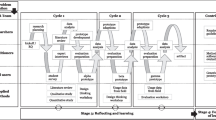Abstract
Student practices are an important aspect in schooling. This article explores a possible solution of this issue for Web students in the field of computer science. Taking a DBMS implementation course as an example, the practical experiences are introduced, including courseware organization, question answering, project assignments and checking for Web Learning. The courseware is featured with: (a) self-navigation by semantic links, (b) seeing before learning, (c) provision of source code and practice-slots, (d) learning with tasks, and (e) personalized interface facilities. The special techniques inside the implementation of a personalized interface, such as user information table, behavior table, topic level tree and the page producing mechanisms are also discussed. A strategy to get the feedback of Web students is proposed, namely, by setting up a shadow class on campus to reflect the feedback of all Web learning students.
Supported by the of National Science Foundation of China grant #60073046.
Access this chapter
Tax calculation will be finalised at checkout
Purchases are for personal use only
Preview
Unable to display preview. Download preview PDF.
Similar content being viewed by others
References
Y. Wang and C. Sun, “Synchronous Distance Education: Enhancing Speaking Skills via Internet-based Real Time Technology,” Proc. of WISE Conference, vol. 2, pp. 168–172, 2000.
Y. Ochi, Y. Yano, and R. Wakita, “Development of Web Customized System for Sharing Educational Resources,” Proc. of WISE Conference, vol. 2, pp. 173–178, 2000.
K. Ateyeh, J. Muelle, and P. Lockemann, “Modular Development of Multimedia Courseware”, Proc. of WISE Conference, vol. 2, pp. 179–187, 2000.
C. Tang, R.W.H. Lau, Q. Li, H. Yin, T. Li, and D. Kilis, “Personalized Courseware Construction Based on Web Data Mining,” Proc. of WISE Conference, vol. 2, pp. 204–211, 2000.
C. Tang, R.W.H. Lau, H. Yin, Q. Li, L. Yang, Z. Yu, L. Xiang, and T. Zhang, “Discovering Tendency Association between Objects with Relaxed Periodicity and its Application in Seismology,” Proc. of ICSC’99: Internet Applications, LNCS 1749, Springer-Verlag, pp. 51–62, Dec.1999.
C. Tang, R.W.H. Lau, Q. Li, T. Li, and Z. Yu, “Distance Courseware Discrimination Based on Representative Sentence Assaying,” Proc. of DASFAA 2001, pp. 92–99, 2001.
C. Tang, T. Li, C. Liu, and Y. Ge, “Classify Web Document by Key Phrase Understanding,” Proc. of WAIM 2001, LNCS 2118, Springer Verlag, pp. 80–88, 2001.
C. Tang, L. Xiang et al., “The Courseware of ‘Implementation of small DBMS in C’”, http://teacher.scu.edu.cn/~chjtang/hbase_html/0cerbase.htm.
C. Tang, L. Xiang, T. Zhang, et al., “The Internal Structure of Database System and its Implementation In C”, Publishing House of Electronic Science and Technology University, 1995.
C. Tang, Z. Yu, Z. You, T. Zhang, and L. Yang, “Mine the Quasi-Periodicity From Web Data,” Journal of Computer, 23(1):52–59, 2000.
R. Agrawal and R. Srikant, “Fast Algorithms for Mining Association Rules,” Proc. of VLDB Conference, Sept. 1994.
Author information
Authors and Affiliations
Editor information
Editors and Affiliations
Rights and permissions
Copyright information
© 2002 Springer-Verlag Berlin Heidelberg
About this paper
Cite this paper
Tang, C., Li, Q., Lau, R.W., Huang, X. (2002). Supporting Practices in Web-Based Learning. In: Fong, J., Cheung, C.T., Leong, H.V., Li, Q. (eds) Advances in Web-Based Learning. ICWL 2002. Lecture Notes in Computer Science, vol 2436. Springer, Berlin, Heidelberg. https://doi.org/10.1007/3-540-45689-9_25
Download citation
DOI: https://doi.org/10.1007/3-540-45689-9_25
Published:
Publisher Name: Springer, Berlin, Heidelberg
Print ISBN: 978-3-540-44041-3
Online ISBN: 978-3-540-45689-6
eBook Packages: Springer Book Archive




